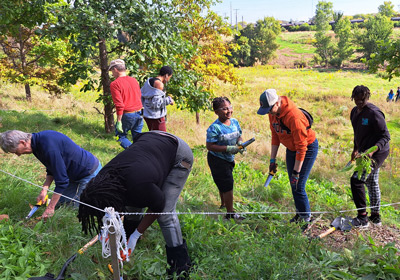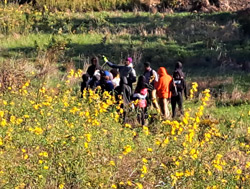“Anybody can love the mountains…but it takes a soul to love the prairie”
– Prairie chronicler, Willa Cather.
Nearby Nature Milwaukee began seriously engaging in urban prairie restoration in Hopkins Hollow this past year, with a ½ acre project that involved three summer student interns. Hopkins Hollow is the name we’ve given to an 18 acre space along Lincoln Creek, owned by the Milwaukee Metropolitan Sewerage District and maintained for flood control. It’s the same area that was adopted by the Sierra Club Great Waters Group in 2017 as part of Milwaukee Riverkeepers Adopt-A-River program. Our work has brought us attention from the community, both the immediate neighbors, and the local media, as in this lovely story by Journal-Sentinel outdoor writer Chelsey Lewis. [read article]

Martina shows a specimen of Prairie Dock
During a September 2021 visit to the area with MMSD Director Kevin Shafer we proposed a short “demonstration trail”. Kevin liked our ideas and less than two months later we broke ground on the trail that starts at Hopkins and Congress Avenues.
The short trail brings you to a wild area where you cannot imagine you are in the middle of the city. It is a beautiful inner-city wild-space where deer roam and wildflowers bloom. Traffic sounds melt away and the sound of birds, crickets and a gurgling waterfall greet the lucky visitor.
During Kevin’s visit, Martina Patterson, Nearby Nature’s resident Land Steward and Youth Educator raised the topic of prairie restoration. As we finished the trail, we began discussion with MMSD about the possibility of expanding our agreement to include prairie restoration. Then, on December 21st, 2021, the Winter Equinox, a group traveled past Mukwonago to the Meyer Prairie Preserve at the invitation of Lamont Smith of the Nature Conservancy (TNC). Our purpose was to learn about prairies and begin to

15 people came out on a volunteer workday to remove teasel, buckthorn, and to plant native wildflowers.
gather seeds for our own Urban Prairie Restoration Project. Besides TNC and Nearby Nature staff, we were assisted by Danitra Jones from Northwest Side CDC, UEC land stewards and Milton Byer of the Audubon Wild Indigo program. At that gathering we collected buckets of yellow prairie coneflower, wild bergamot (bee balm) and prairie clover.
In the coming year we are planning several cultivation methods to introduce these seeds to Hopkins Hollow. This past summer brought lots of other activity to the area as well. Our youth interns sampled areas in the 1/2 space and identified 30 plant species, a mix of natives and invasive.

Carmen High School Kids tour the prairie and learn about wildlife habitat
Many bushels of invasives were removed, mostly wormwood, teasel, and wild parsnip. At our invitation, Zachary Kron, Southeastern Wisconsin Regional Planning Commission Rare Plant Specialist surveyed a large section of the hollow and identified close to 100 plant varieties. After the interns were gone, we held a volunteer prairie workday and 15 helpers came out, dug teasel and planted some native plants. Full prairie restoration can take several years, but with partnerships with groups like GWG, MMSD, The Nature Conservancy and others, we hope this work will expand and flourish. Already this fall, school groups have been coming to the area to use it as a living classroom and connect with nature.

Recent Comments